
Semana Santa – ‘Holy Week’ in English – is one of Spain’s most profound and visually striking religious and cultural celebrations. Taking place during the week leading up to Easter Sunday, it commemorates the Passion, Death, and Resurrection of Jesus Christ and is marked by dramatic processions featuring ornate floats carried through the streets of many cities and towns across the country on the shoulders of devoted members of religious brotherhoods. Blending deep spiritual devotion with artistic expression and community pride, Semana Santa offers a powerful window into Spanish identity and heritage.
Article Contents
- The Origins of Semana Santa
- Semana Santa – The Days Explained
- The Must-See Semana Santa Events in Spain
- Traditional Spanish Dishes for Semana Santa
- Semana Santa Traditions in the Comunidad Valenciana
- Some Do’s and Don’ts
The Origins of Semana Santa
The roots of Semana Santa can be found in the medieval religious traditions of the Christian church. By the 13th century, during the reign of Alfonso X of Castile, religious processions were becoming an important part of Spain’s Catholic practices, often connected with Lent and culminating in the Easter celebrations. These early processions were a way for the faithful to publicly express their devotion and to reflect on the suffering and death of Jesus Christ.
The Catholic Church has played a pivotal role in shaping the Semana Santa tradition. Over time, processions became more elaborate, not only as expressions of religious devotion but also as public displays of faith and solidarity. The Church would organize these processions to ensure that the public was reminded of Christ’s suffering and the redemption it promised. The Cofradías, religious brotherhoods made up of local communities, became central to organizing and leading the processions. Each brotherhood would be responsible for carrying one or more floats, known as pasos, that depicted scenes from the Passion of Christ.
The Renaissance and Baroque periods in Spain brought about significant changes to the visual and artistic elements of Semana Santa. Artists and sculptors began to create highly detailed religious imagery, including statues of Christ, the Virgin Mary, and scenes from the Passion narrative. These sculptures would become the focal point of the floats carried through the streets during the processions.
In the Baroque period, the processions became larger and more dramatic, often incorporating theatrical performances to capture the full emotional power of Christ’s sacrifice. The Baroque style, known for its grandeur and emotional intensity, shaped many of the religious artifacts, altarpieces, and processional floats that would be used in Semana Santa processions across Spain.
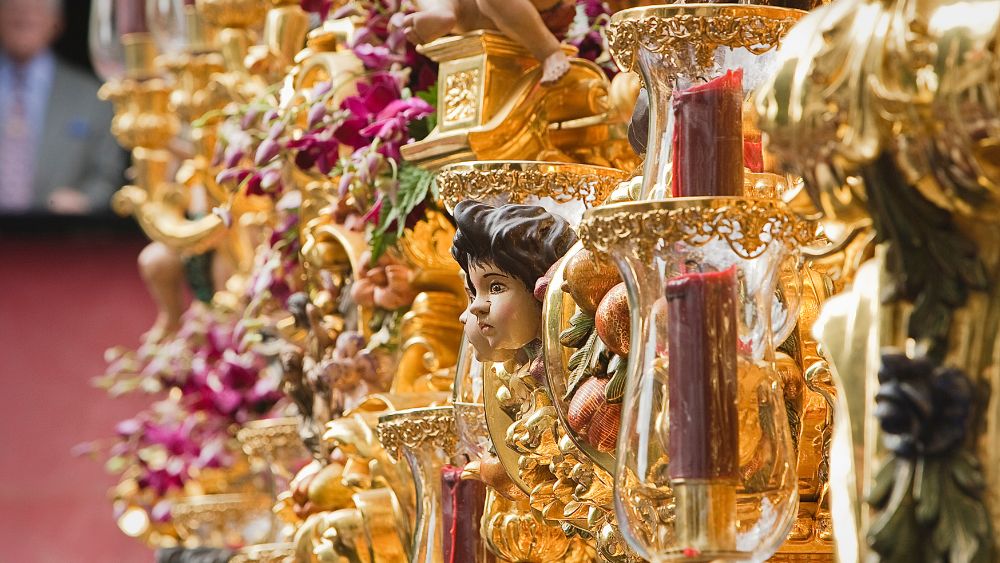
By the 18th century, Semana Santa had become firmly established as a major religious and cultural event in Spanish society. The processions were an opportunity to demonstrate both religious piety and social solidarity, and they attracted large crowds, including members of the nobility and the general public. The Cofradías continued to play a vital role in organizing the events, and their processions became more sophisticated and elaborate.
During the 19th century, Spain’s political and social upheavals, including the Napoleonic wars and the rise of secularism, caused some disruption to the religious traditions of Semana Santa. However, in the aftermath of the Spanish Civil War (1936–1939), Spain saw a resurgence of interest in religious observances and Semana Santa became a powerful symbol of both Catholic identity and Spanish nationalism.
Today, Semana Santa is celebrated throughout Spain, but the most iconic processions are found in Andalusia, particularly in Seville, Málaga, and Córdoba. The processions are a blend of religious devotion, artistic expression, and social tradition, and they have become one of the country’s most important tourist attractions. The brotherhoods, now organized as religious associations, continue to carry out the sacred duty of representing Christ’s Passion in public, with each brotherhood having its own set of rituals, traditions, and iconography.
Despite Spain’s increasing secularism in modern times, Semana Santa continues to be an essential cultural and religious event. In some areas, the processions have evolved to incorporate elements of local music, theatre, and art, making them both a spiritual observance and a form of artistic and cultural celebration. Flamenco music, particularly in Andalusia, has become intertwined with Semana Santa, adding an additional layer of emotional depth and passion to the processions.
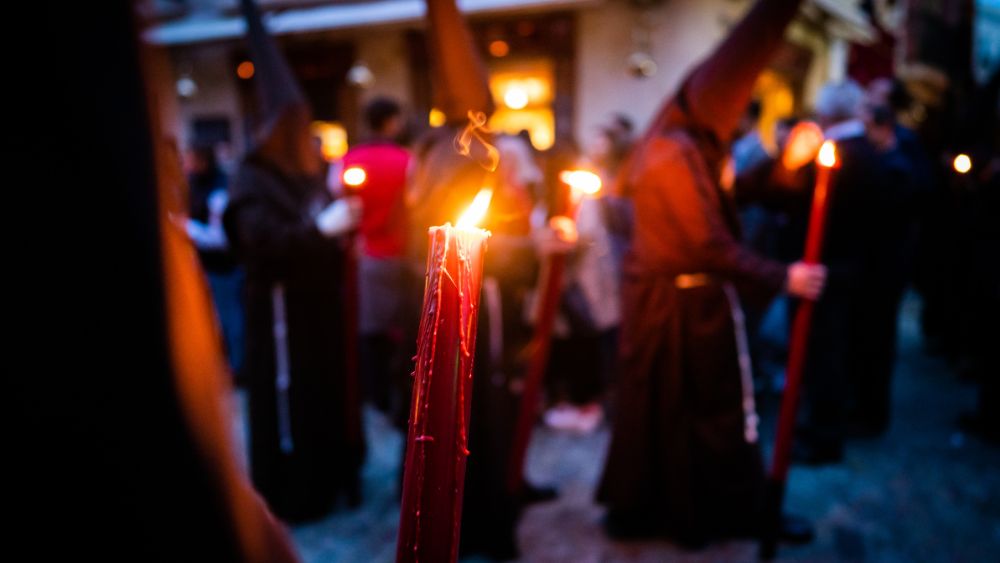
Semana Santa · The Days Explained
Each day of Semana Santa in Spain commemorates a specific event from the Passion of Christ, leading up to His crucifixion and resurrection. While the core themes are consistent nationwide, the celebrations and emphasis can vary significantly from one region to another; some days may be more prominent in Andalusia, while others take on deeper meaning in places like Castile (the central and northwestern heartland of Spain), Valencia, or Catalonia.
Viernes Dolores (Friday of Sorrows)
This day is observed on the Friday before Domingo de Ramos (Palm Sunday) by many places in Andalusia, Murcia and Castile which hold processions dedicated to the Virgen de los Dolores (Our Lady of Sorrows), commemorating the suffering of the Virgin Mary, particularly her sorrow during Jesus’ Passion. In Cartagena, in the early hours of the morning, a procession by the hooded figures of the Cofradía del Cristo del Socorro bearing the weight of the images of Cristo del Socorro and the Virgen de la Soledad del Consuelo and accompanied by the beat of military-style drums, is the earliest Semana Santa procession in Spain.
In Xàbia, the Brotherhood of Santo Rosario organises a meditation of the Seven Sorrows, the seven events in the life of the Virgin Mary that were very painful and sorrowful for her, in the church of San Bartolomé.
Sábado de Pasión
Increasingly seen as a prelude to Semana Santa, it is a day dedicated to reflecting on the suffering of the Virgin Mary and the upcoming Passion of Christ. On this day, the Via Matris is often observed in which the Seven Sorrows of the Virgin Mary are meditated upon.
In 2024, the Via Matris was restored in Xàbia, observed in the early morning of this day when the image of the Virgen de los Dolores carried through the streets of the historic centre, visiting seven niches along the route for moments of reflection.
Domingo de Ramos (Palm Sunday)
The official start of Semana Santa, this day commemorates Jesus’ triumphal entry into Jerusalem, greeted with palm branches, and people carry palm fronds and olive branches to be blessed as the special mass that is held on this day. Many cities and towns have their first major processions of Semana Santa on this day, especially in Sevilla, Zamora and Alicante.
In Xàbia, there is a special blessing in the Convent followed by a procession through the streets of the historic centre and a mass. A similar act takes place down in the port area, centred around the port church.
Lunes Santo (Holy Monday)
This day commemorates the cleansing of the temple and Jesus’ confrontations with authorities and there are important processions, particularly in Andalusia and in Sevilla.
In Xàbia, the image of Santisimo Cristo del Convent is carried to the church of San Bartolomé in the heart of the historic centre in the evening of this day.
Martes Santo (Holy Tuesday)
This day commemorates Jesus predicting His betrayal as Judas’s plans begin to unfold. Across Spain, processions continue, but now the tone is becoming more contemplative and in Granada and Málaga, more dramatic floats are carried through the streets. In Castile, some towns begin night processions by torchlight.
Miercoles Santo (Holy Wednesday)
This day is also known as “Spy Wednesday” and it commemorates Judas’s agreement to betray Jesus, a day for devotees to consider personal reflection on loyalty, temptation, and staying faithful to Jesus. It is a day that sets the stage for the forthcoming Last Supper and the Passion of Christ. Emotional penitential processions are common and some regions focus on the Virgin of the Bitterness or Suffering. In Murcia, there is a colourful evening procession called La Procesión de la Sangre which has been held since 1689, during which the archconfraternity of ‘Los Coloraos’ distribute sweets, boiled eggs, and other treats to spectators, reflecting Murcia’s unique Semana Santa customs.
Jueves Santo (Holy Thursday / Maundy Thursday)
This commemorates the Last Supper, the Washing of the Feet and the institution of the Eucharist, the Holy Communion ceremony of taking bread and wine as the body and blood of Christ; it is also known as the Lord’s Supper. Many devotees attend Mass of the Lord’s Supper. In Andalusia, processions stretch into the night and Sevilla holds La Madrugá, a series of solemn processions that commence after midnight and continue into the morning hours. The event draws significant crowds, with more than half a million people gathering in the streets of Seville to witness the processions. In some regions, there is foot-washing or night vigils at monuments.
Viernes Santo (Good Friday)
This day commemorates the Passion, Crucifixion and Death of Jesus and is the most solemn day of Semana Santa. Morning and evening processions are widespread across Spain, some of which are silent, other accompanied by solemn music and drumming. In Zamora and Valladolid, the processions are especially austere and moving, whilst in Andalusia, they are often theatrical and emotionally charged.
In Xàbia, there are two processions – the early-morning Vía Crucis sees the town’s treasured image of the Nazarene carried on the shoulders of its brotherhood back up to the iconic blue-domed chapel of Calvario along the winding Stations of the Cross before being returning to church of San Bartolomé. And then, as the sun dips towards the horizon, another procession takes place in the heart of the historic centre. Called the Procesión de Santo Entierro, it commemorates the funeral of Jesus after the crucifixion and is a solemn affair in which the town’s residents silently accompany images of Jesus and the Virgin with candles.
Sábado Santo (Holy Saturday)
This day commemorates the time that Jesus lies in the tomb and is a time of silence and mourning for the devoted. There are few processions and churches are often empty and silent. As night falls, the Easter Vigil marks the beginning of joyful celebrations.
In Xàbia, the late night Easter Vigil begins outside the church of San Bartolomé with the lighting of a big candle from a small fire burning in the church square. This candle – the ‘Cirio Pascual’ – represents the risen Christ, light of the world and its symbolism is very rich and deep in Christian liturgy. The priest will then carry the candle inside the darkened church where the hundreds of smaller candles held by the faithful are gradually lit in succession from this one flame and the inside of the church starts to glow warmly as the congregation confirms to themselves that the resurrection of Christ is the source of eternal life and that it always overcomes darkness.
After the long Easter Vigil mass , there is the ‘Procesión del Encuentro’, an act that has recently returned to the religious programme in Xàbia. During this special moment, as the clock ticks towards midnight, two images are carried from opposite sides of the church square – that of the Virgin Mary and that of the Risen Christ – to meet outside the door of San Gil in a symbolic moment that reenacts the meeting of the Risen Jesus and his sorrowful Mother Mary on the road. It’s a joyous moment accompanied by firecrackers and confetti.
Domingo de Resurrección (Easter Sunday)
This day commemorates the Resurrection of Christ and is one of joyful processions, many of which feature what is known as the “encuentro” – a symbolic meeting of Jesus and the Virgin Mary. Music, flowers, and white garments replace the sombre tones of the earlier days of Semana Santa.
In Xàbia, it has become tradition for local fiesta groups, known as peñas, and associations to come together for their own “encuentro” around the church during the late morning and early afternoon, erecting temporary bars selling drinks and snacks as well as stalls offering craft items or souvenirs. This is a way for them to raise money for the particular cause, whether it be for charity or to help fund their participation in the town’s fiestas, such as the Moors and Christians.
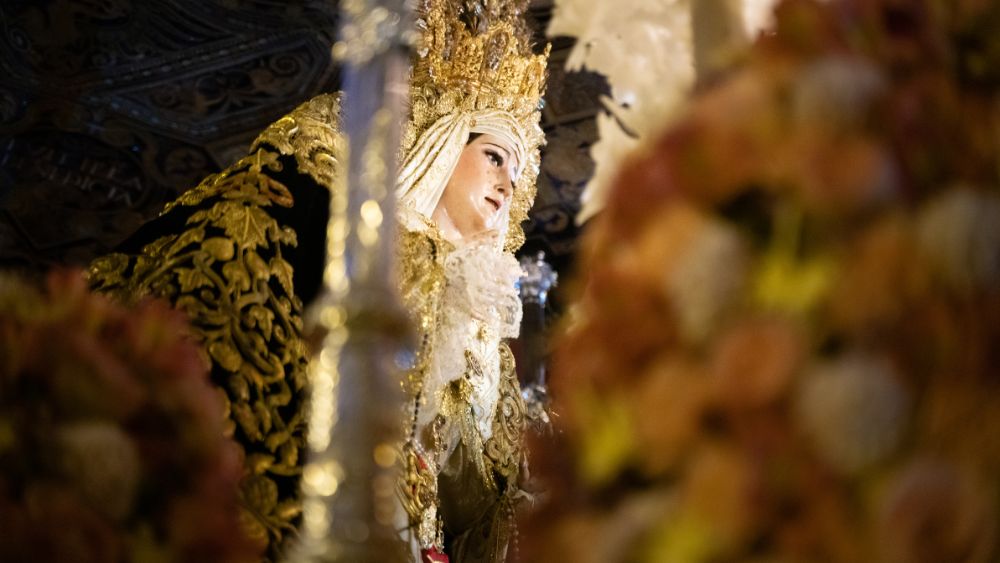
The Must-See Semana Santa Events in Spain
Semana Santa in Spain is packed with powerful and moving moments. From the emotional processions to the dramatic reenactments, each moment during these days offers a unique experience. This is a list of some of the unmissable and perhaps unique events to experience; there are no doubt many others.
La Madrúga (Sevilla)
La Madrúga is an all-night religious procession that takes place from late night Maundy Thursday into early morning Good Friday and is the heart of Sevilla’s Semana Santa which attracts thousands of people. Several cofradías parade through the streets, carrying beautifully decorated pasos, grand floats which often show scenes from the Passion of Christ or images of the Virgin Mary in mourning. The atmosphere is deeply spiritual, emotional, and uniquely Andalusian, the sombre mood occasionally broken by the sound of the saetas, spontaneous flamenco-style prayers sung from balconies. It’s a moving experience, even for those who are not religious.
Official Link: Consejo General de Hermandades y Cofradías de Sevilla
El Cristo de la Buena Muerte (Málaga)
El Cristo de la Buena Muerte is one of the most iconic religious images in Spain and it holds a deep and symbolic connection with La Legión Española, one of Spain’s elite military units. The Legion arrives by military ship during the morning of Maundy Thursday and march through the port area to the Plaza de Fray Alonso de Santo Tomás. In one of the most widely watched moments of Semana Santa in Spain, the Legionnaires collect the image from its Brotherhood and carry it on their shoulders around the square, singing their famous hymn “El Novio de la Muerte”, a song that encapsulates the Legion’s ideals, before carrying it inside the church to be hoisted onto its throne in preparation for La Procesión del Cristo Mena later in the evening, a procession in which the Legion also participates, accompanying the image being carried by the Cofradía de Mena through the streets of the city of Málaga.
Official Link: Congregación de Mena | Semana Santa de Málaga
Procesión General de la Sagrada Pasión (Valladolid)
One of the most important and traditional religious events in Spain, the Procesión General de la Sagrada Pasión in Valladolid dates back to early 16th century. It has evolved over time, but its core purpose has always been religious devotion. The procession normally takes place on Good Friday and involves a long parade of large, heavy floats through the streets of the city carried by bearers called anderos who shoulder the heavy wooden structures, showcasing the immense dedication involved. Some of these floats are centuries old and are considered works of art due to their intricate craftsmanship and religious significance. In 1980, the event was recognized by the Spanish Ministry of Culture as an event of International Tourist Interest.
Official Link: Valladolid Cofrade | Semana Santa en Valladolid
Procesión del Cristo de los Gitanos (Granada)
The Procesión del Cristo de los Gitanos is one of the most iconic and deeply rooted religious and cultural events in Granada which stands out due to its unique traditions and connections to the gypsy community of the city. The procession follows a traditional route, weaving through the narrow and winding streets of Granada, lit by candlelight and surrounded by the haunting sounds of flamenco. The backdrop of the Alhambra, the iconic Moorish palace, adds to the magic of the event, especially when viewed from the Albaicín neighbourhood, where the procession often passes. In addition, bonfires are lit by the local community, symbolizing purification and guiding the procession through the night, giving the event an almost mystical atmosphere, especially in the dark, narrow alleys of the Albaicín.
Official Link: Hermandad Sacramental Los Gitanos
Rompida de la Hora (Calanda)
The Rompida de la Hora is a distinctive and deeply rooted tradition celebrated annually at 12 noon on Good Friday in the town of Calanda, Aragón, Its origins date back to a legend from 1127. According to the tale, Christian residents of Calanda were unaware of an impending Moorish raid. A vigilant shepherd, noticing the approaching threat, used a tambourine-like instrument to alert the townspeople, enabling them to seek refuge in time. This act of warning and unification is commemorated annually through the synchronized drumming. At the stroke of noon, a cacophony of drums and bass drums erupts simultaneously, symbolizing the tremor felt upon Christ’s death. The unified drumming is so intense that it causes the ground and nearby structures to vibrate, creating a profound sensory experience.
Official Site: Cofradía Jesús Nazareno de Calanda
Procesión de la Soledad (Tarragona)
The Procesión de la Soledad is an evocative and solemn religious procession held on Holy Saturday in the city of Tarragona in Catalunya. The event commemorates the mourning of Mary, the mother of Jesus, after his crucifixion and it is unique in that it involves only women who participate, a tradition that emphasizes the role of female mourning and the maternal sorrow of Mary. They dress in traditional mourning attire, often in black robes, carrying candles or torches and some of the women wear hoods or veils, symbolizing both devotion and mourning.
Link: Tarragona Living History
Dansa de la Mort (Verges)
The Dansa de la Mort is a traditional procession that takes place on Maundy Thursday in the town of Verges, Catalunya. Dating back to the Middle Ages, it has been inspired by the Danse Macabre, a European tradition that portrayed the universality of death through art, literature, and performances. The Verges version evolved as part of the local religious observances, specifically around the Passion of Christ. During the procession, people dress up as skeletons, representing the idea that death comes for everyone, regardless of status or wealth, which dance to rhythmic drumming, the dancing symbolizing death’s inevitability and its presence in life.
Official Link: La Processó de Verges
Quema de Judas (Castilblanco de los Arroyos)
The Quema de Judas (Burning of Judas) takes place on Easter Sunday in the town of Castilblanco de los Arroyos in Andalusia and involves the creation of life-sized effigies called “Judas dolls” or “Juas”, often representing well-known public figures or symbolic representations of negative traits. They are placed in various locations throughout the town and are set on fire as a symbolic act of purging evil and celebrating renewal. This ritual is part of a broader tradition observed in various parts of Spain, where communities create and burn effigies of Judas Iscariot, the disciple who betrayed Jesus, as a means of symbolizing the triumph of good over evil. It has been recognized as an Andalusian Festival of National Tourist Interest.
Official Link: Quema del Judas | Turismo de la Provincia
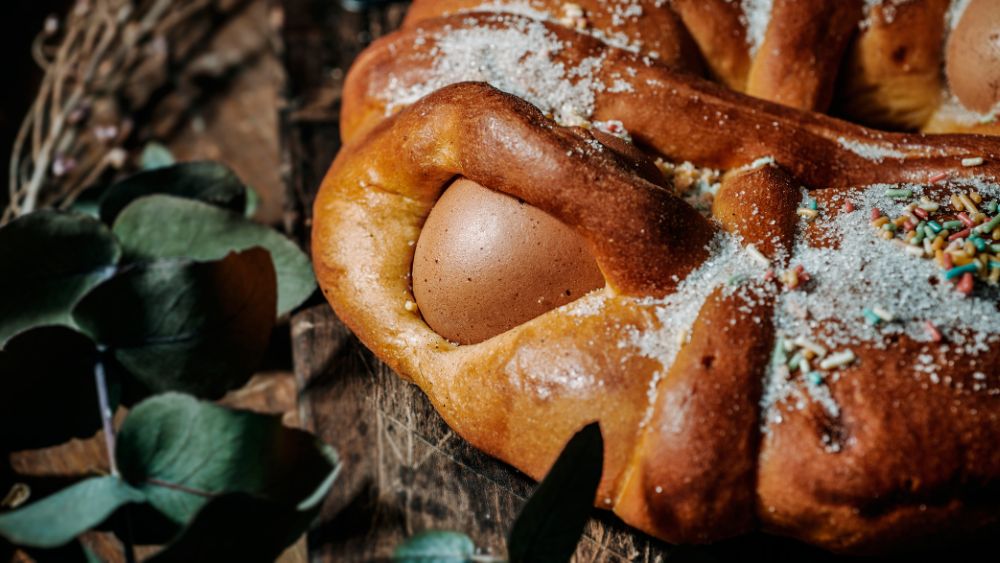
Traditional Spanish Dishes for Semana Santa
From hearty stews in Castilla y León to sweet treats in Catalonia, regional specialties are an essential part of the Semana Santa experience, showcasing the country’s vibrant gastronomic culture. Here’s a look at one traditional dish from each of Spain’s regions, highlighting the regional flavours and culinary traditions that make this time of year so special.
Andalusia – Potaje de Vigilia
Potaje de Vigilia is a meatless stew made with chickpeas, cod, spinach, and other vegetables, representing a balance between the religious observance of fasting and the desire to enjoy a nourishing, flavourful meal, it is often shared in family gatherings, and the slow-cooked nature of the stew makes it ideal for communal eating.
Aragon – Migas
Migas is a traditional Aragonese dish made from leftover bread, typically fried with garlic and often served with ingredients like chorizo, bacon, or grapes, especially during Semana Santa when it is a popular meal enjoyed after religious processions or gatherings. During this time, it’s often served with grapes or fried eggs, and sometimes with fish or cod, in line with Lenten dietary customs.
Asturias – Faba Asturiana (Fabada)
Faba Asturiana is a traditional dish from the region of Asturias which is a rich and hearty bean stew made with large white beans (fabes), typically cooked with chorizo, morcilla, pork shoulder (lacón), and sometimes bacon. The dish is known for its smoky, savory flavor and thick, comforting texture. While not specifically a religious Easter dish, its warming and generous nature makes it perfect for gathering around the table with loved ones during this spring celebration.
Islas Baleares – Coca de Llavanera
Coca de Llavanera is a traditional sweet flatbread from the Balearic Islands, especially enjoyed around Easter. It’s a soft, slightly sweet pastry made with simple ingredients like flour, sugar, eggs, olive oil, and sometimes milk or aniseed. The dough is typically topped with sugar and pine nuts, and sometimes flavoured with lemon zest or cinnamon. During Easter, it is often shared with family and friends, either as a treat after church or during springtime picnics.
Canarias – Papas con Mojo
Papas con Mojo is a traditional Canarian dish made with small, wrinkly potatoes called papas arrugadas boiled in salted water, often served with a rich sauce full of flavour called mojo. There are two main types of mojo: mojo rojo (red, slightly spicy, made with peppers, garlic, and paprika) and mojo verde (green, with fresh herbs like cilantro or parsley). It is especially popular during Semana Santa as part of family gatherings and festive meals, often served alongside fish or other meatless dishes in keeping with traditional Easter customs.
Castilla-La Mancha – Sopa de Ajo
Sopa de Ajo is a humble yet tasty soup made with garlic, stale bread, paprika, olive oil, and often a poached egg on top, very traditional in Castilla-La Mancha. Sometimes bits of ham or chorizo are added, though during Semana Santa, it’s commonly made without meat, keeping it simple and meatless for Lenten tradition and offering comfort and warmth after religious processions and fasting. It’s a perfect example of how basic ingredients can create something deeply satisfying.
Castilla y León – Hornazo
Hornazo is a savoury meat-filled pastry that’s strongly tied to the Easter celebrations in Salamanca and other parts of Castilla y León. Traditionally eaten on Lunes de Aguas (Easter Monday), hornazo is both a symbolic dish and a culinary treat, with roots that go deep into local history and festive customs. At its core, Hornazo is a meat pie made with a filling of chorizo, pork loin, and hard-boiled eggs; sometimes it also includes jamón serrano or other cured meats. But it’s far more than just a meat pie – it’s a slice of Spanish history wrapped in golden pastry.
Catalonia – Mona de Pascua
The Mona de Pascua is more than just a cake – it’s a beloved culinary and cultural symbol of Easter in eastern Spain. Traditionally given by godparents to their godchildren on Easter Sunday or Easter Monday, the mona marks the end of Lent and the joyful celebration of the Resurrection. The classic Mona de Pascua is a ring-shaped brioche cake made from enriched dough with eggs, sugar, and sometimes aniseed. What makes it unique is the hard-boiled eggs, which are often dyed in bright colours, which are placed on top of the cake, symbolizing fertility and rebirth.
Comunidad Valenciana – Buñuelos
Buñuelos are a traditional Valencian treat, especially popular during Semana Santa. They are small, deep-fried dough balls, often made with pumpkin, giving them a soft texture and slightly sweet flavour. Typically, they’re dusted with sugar and best enjoyed hot, often paired with a cup of hot chocolate. In Valencia, eating buñuelos is a beloved tradition at Semana Santa, bringing families and friends together to share this simple yet delicious delight.
Extremadura – Torta de Aceite
Torta de Aceite is a traditional sweet flatbread, especially popular during Semana Santa. It’s made with simple ingredients like flour, olive oil, sugar, anise seeds, and sometimes a hint of cinnamon or orange zest. The dough is rolled thin, brushed with olive oil, sprinkled with sugar, and then baked until golden and slightly crispy. It’s often enjoyed with coffee or hot chocolate, symbolizing the region’s rich culinary and cultural traditions.
Galicia – Empanada Gallega
Empanada Gallega is a traditional savoury pie which is made with a thin, yeasted dough and filled with a tasty mix of ingredients like onions, peppers, and either tuna, cod, pork, or chorizo, although during Semana Santa it often features salt cod, known as bacalao, and raisins, a combination that blends salty and sweet flavours and it’s a popular dish to share with family during Semana Santa, often eaten cold or at room temperature as part of a larger spread.
La Rioja – Menestra de Verduras
Menestra de Verduras is a traditional vegetable stew which is especially popular during Lent when many people avoid eating meat. It is made from fresh spring vegetables, typically artichokes, asparagus, peas, green beans, and carrots. The vegetables are usually cooked separately to keep their colours and textures, then gently combined with a light sauté of onion and garlic, sometimes with a bit of jamón (cured ham) for flavour, though this is often left out during Easter to keep it meat-free.
Comunidad de Madrid – Torrijas
Torrijas are a traditional dessert, especially popular in Madrid during Semana Santa, which are similar to French toast: slices of stale bread soaked in milk or wine, then dipped in egg, fried in olive oil, and sprinkled with sugar and cinnamon. Sometimes they’re topped with honey or syrup. Sweet, comforting, and deeply tied to Semana Santa traditions in Spain, they are a delicious way to use simple ingredients with rich flavour and meaning.
Región de Murcia – Caldero
Caldero is a traditional Murcian dish, especially popular during Semana Santa, which is a hearty seafood stew typically made with rice, fish, and a rich broth full of flavour. The key ingredients often include a variety of local fish like monkfish or bass as well as shellfish such as prawns or clams. The dish is cooked with vegetables, including tomatoes, garlic, and onions, and is seasoned with paprika and saffron to give it a distinct and vibrant flavour. It is is usually served with alioli which adds an extra layer of richness to the meal and it’s a perfect dish for large gatherings, making it a staple of communal meals during Semana Santa celebrations in Murcia.
Comunidad Foral de Navarra – Piquillos Rellenos de Bacalao
Piquillos Rellenos de Bacalao is a traditional dish consisting of piquillo peppers, which are mild, sweet, and slightly smoky, stuffed with rehydrated bacalao mixed with garlic, olive oil, and sometimes other ingredients. The combination of the tender, flavourful peppers with the rich, flaky cod creates a perfect balance of textures and tastes. During Semana Santa, when fish and seafood are commonly eaten due to religious traditions, this dish becomes especially popular.
País Vasco – Bacalao a la Vizcaína
Bacalao a la Vizcaína is a traditional Basque dish, especially popular during Semana Santa which features bacalao cooked in a rich sauce made with tomatoes, red peppers, garlic, onions, and sometimes a bit of white wine. The dish is hearty yet simple, with the tender cod taking centre stage, while the sauce adds a deep, savoury richness. Salted cod, being a preserved fish, was historically consumed during Lent and Semana Santa when meat was forbidden, making it a staple of Basque Easter celebrations.
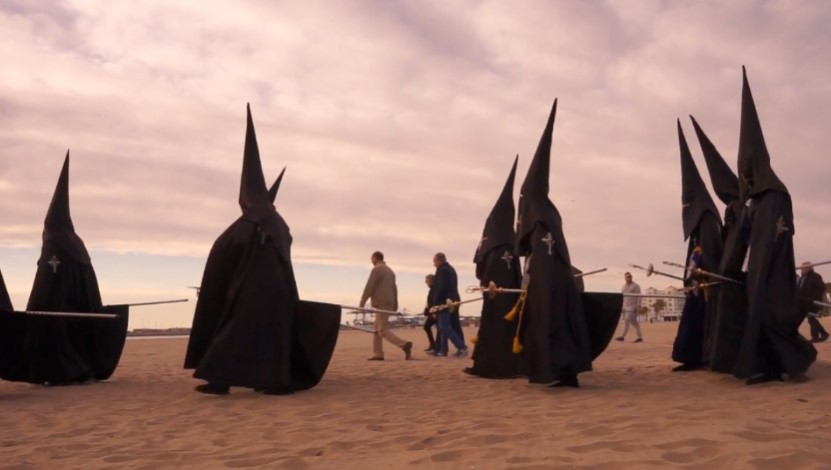
Semana Santa Traditions in the Comunidad Valenciana
Semana Santa Marinera (Valencia)
Semana Santa Marinera is a distinctive celebration held in the city of Valencia’s coastal neighborhoods of El Cabanyal, El Canyamelar and El Grau which was officially recognized as a Fiesta of National Tourist Interest in 2011. It uniquely intertwines the city’s rich maritime heritage with traditional Semana Santa observances. On Good Friday, the image of Cristo del Salvador is taken in procession towards the edge of the sea in El Cabanyal where it is momentarily lifted to face the water. This act is deeply symbolic, as the sea represents a transition from mourning to hope, much like the resurrection theme that follows later, and is one of the most iconic moments of Semana Santa Marinera. Another unique and traditional custom that forms part of the Semana Santa Marinera celebrations is the Trencà dels Perols, which literally translates to the “Breaking of the Pots”. Taking place at midnight on Holy Saturday, local residents throw old ceramic pots, known as perols, out of their windows into the streets below. The pots are typically broken, symbolizing the breaking of mourning and the loud noise of the breaking clay is said to signify the end of sadness and the anticipation of the joy of Easter Sunday. It is one of the most anticipated moments of the Semana Santa Marinera festivities.
Official Link: Semana Santa Marinera de València
Semana Santa in Orihuela
One of the most spectacular weeks is in Orihuela. Declared a Festival of International Tourist Interest in 2010, it has a series of peculiarities that make it unique in the world. One of the most impressive processions is the one that takes place on Holy Thursday from eleven o’clock at night: that of the Santísimo Cristo del Silencio. As its names suggests, the most striking feature of the procession is the absolute silence maintained during the entire event and is meant to reflect the sorrow and the deep contemplation of the Passion of Christ, creating a sombre and reflective mood throughout the city. And then, on Holy Saturday, is the Santo Entierro de Cristo, which features the Caballero Cubierto – the “Covered Knight” – who assumes the task of guarding and accompanying the sacred images, especially those depicting Christ’s body in the tomb or the Virgin Mary in mourning. It traces its origins back to the beginning of the seventeenth century, when, in order to recognize the merits, honor, loyalty and love for the city, the city government decided to appoint the Covered Knight.
Official Link: Orihuela: historia del mediterráneo
La Rompida de la Hora (L’Alcora)
At midday on Good Friday, the town of l’Alcora bursts into life with the thunderous sound of over a thousand drums beating in perfect unison, creating an unforgettable atmosphere. Known as the rompida, it symbolizes the sorrow of Christ’s death. At 12 noon a single drummer steps forward to strike their drum four times, breaking the silence and triggering a wave of sound as thousands of drums erupt in response, filling the square with an overwhelming roar. Since its start in 1991, l’Alcora’s drum procession has drawn visitors from all over, eager to experience the powerful emotions stirred by the resonating beats. In 2018, it was recognized by UNESCO as an Intangible Cultural Heritage of Humanity.
El Encuentro Glorioso (Torrent)
The “aleluyas” tradition in Torrent is a unique custom celebrated on Easter Sunday during the “Glorious Encounter,” marking the end of Holy Week in the town. At the heart of the tradition is the figure of the Reina del Encuentro and the Ángel de la Resurrección, who represents Doña Germana de Foix, the vice-queen of Valencia. According to tradition, she presided over the meeting between the Virgin Mary and the resurrected Jesus, and she established that a young woman from the town would represent her in this event in her absence. Every year, a member of the local brotherhoods is chosen to embody the Queen, accompanied by her attendants and pages. Upon arrival in the main square, she announces, “Christ has risen! Hallelujah, hallelujah, hallelujah!” proclaiming the resurrection of Jesus. At this moment, the Carxofa, a structure designed for the occasion, is opened, releasing thousands of small strips of paper known as aleluyas, which contain poetic verses praising the Reina or offering satirical comments on local events and the brotherhoods.
Official Link: Historia Reina del Encuentro y Ángel de la Resurrección
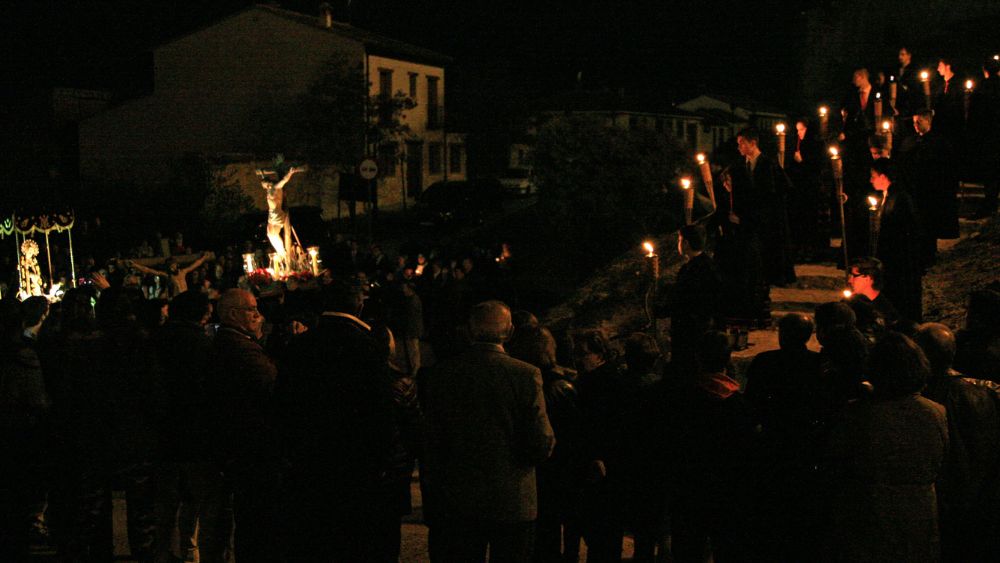
Finally … some do’s and don’ts
Remember that Semana Santa is a religious event. Approach all ceremonies and processions with respect, whether or not you are religious yourself. In addition, Semana Santa is deeply sacred to many in Spain. Criticizing the religious significance of the week can be seen as offensive, especially in smaller towns where religious traditions run deep.
Penitents often walk in the processions as an act of personal devotion and repentance, sometimes walking barefoot or in silence. Be aware not to block their path or disturb their meditative experience.
While it is okay to take photos of the floats or the general scene, avoid using flash photography or taking pictures of the penitent participants (people wearing hooded robes) during moments of deep reverence. Always ask for permission before taking close-up photos. Do not step in front of the floats or get in the way of the participants. Stay on the sidewalks or designated areas.
It’s common to wear respectful clothing when attending religious services or processions. In many towns and cities, modesty is valued, so avoid wearing overly casual or revealing attire. Smart casual is often appropriate.
Silence is a powerful part of the experience, especially during processions. When the floats or images pass by, remain quiet to allow for reflection and meditation. Avoid speaking loudly or laughing during religious services. Disruptions can be considered disrespectful by many Spaniards.
Finally, Semana Santa is a time of reflection, devotion, and respect. Refrain from drinking or engaging in noisy, rowdy behaviour. Public drunkenness is frowned upon, and such behaviour detracts from the serious nature of the observances.

